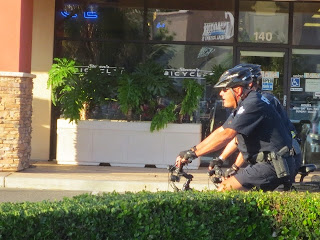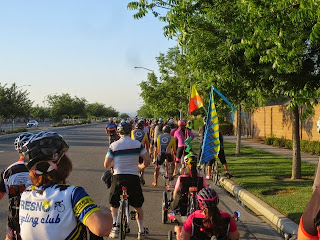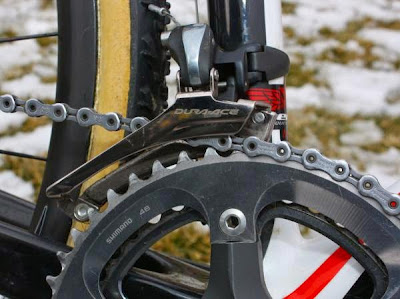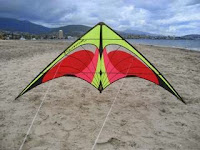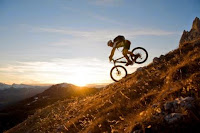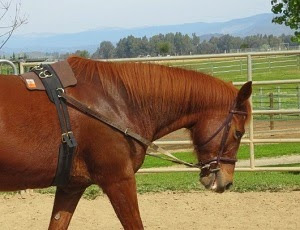[Editor's Note: The Bike Shop is a new feature area for the blog which will focus on cycling.]
Intro
Get Educated
Bikes in General
Bike Stores
Bike Pricing
Intro
Over the last year, I've learned loads about
bicycles and cycling. Cycling has a lot of benefits: it's good for fitness, it's outdoors and it's also indoors. It can be as flexible as you need in both time and cost investment. Bikes can fit nearly every fitness level, and there's nearly nothing that can't be altered to make cycling enjoyable regardless of physical limitations. You can go gung-ho and get into competitions or you can bike for fun and your own enjoyment. There are so many variations on cycling activities these days: there's something for everyone.
One thing that nearly everyone who has not been a cycle enthusiast before will find out: There's more to a bike these days than 2 wheels, a seat and handle bars. A lot more.
As I've been kickin'-the-tires on this issue, I figured I'd pass on the information for anyone who's interested in checking out cycling as a fun activity.
Get Educated
Before you actually run out and buy a bike, it's helpful to “
Get Educated”. Do some homework on what you want to do before you head down to the first place you find that sells bikes and drop a lot of money on a bike that most likely won't work for you, won't do what you want, won't be fun and will end up in the next garage sale.
There are a lot of good websites that have basic information and some bike stores and sporting goods shops have "
Cycling 101" courses for free or small fee. REI.com, the big sporting goods chain, has regular classes on cycling: some are free seminars and some are fee-based hands-on learning sessions.
Local bike shops often have a beginner course and a good bike shop will spend time answering all your questions and will not pressure you to buy before you are ready and completely informed about what you are getting. Bike shops do a lot of repeat business and they know that once you start cycling you will be a regular customer. They want you feel comfortable and to come back to them if you have issues or need maintenance/repairs. Good bike shops will invest in you as much as you invest in them.
There are some sharks out there too waiting to gobble up your money and sell you anything, so visit as many shops as you can to look at their inventory, talk to as many bike pros as you can to ask why one bike is different from another, the pros and cons of certain types of bikes and their intended use.
There are over a dozen specialty bike stores near me that are privately owned. There are also the big sporting goods stores and department stores too. The amount of information you get from a department store or from an on-line ordering description may not be enough to make a good decision. Take your time and find an outlet that is more than “cash and carry”.
Bikes In General
When I was a kid, I was lucky to have a bike at all. My brother got a 10 speed racing bike, I got a regular bike: the kind with 1 gear that you pedaled backwards to stop (aka: coaster bike). The old coaster bike was heavy, hard to pedal, it was a workout to ride and it wasn't fun. It was transportation but even at that it wasn't very good. I borrowed my brother's 10 speed as often as I could sneak it. It was fast, it was easy to ride and it was fun.
- If you want to cycle; fun wins every time.
- Fitness will follow if it's fun.
- If it's not fun you won't be cycling very long.
- Go for fun. Fun Wins.
There are
loads of different kinds of bikes and they all have their specialty uses.
Road bikes: have skinny tires, lots of gears and hand brakes. They are lighter weight than other bikes. Designed to go on paved roads and paved bike paths.
Mountain bikes: have fatter knobbly tires, lots of gears and hand brakes. They have shock absorbers front and rear. They are heavier than road bikes. They can go on paved roads and bike paths but are designed to go on dirt paths and dirt trails.
Hybrid bikes: look more like a mountain bike than a road bike. They have fat knobbly tires for dirt paths and may have front shocks. It's an in between bike for multiple uses. Often cheaper than the specialty Mountain/Road bike. It's often the first bike you buy and it's the first bike you get rid of when you find “It isn't fun”. It can be best or the worst of both worlds.
Bike Stores
Bikes come in all price ranges and for the most part you will get what you pay for, unless you end up in
The Shark Pool. Good bike stores will help you find the best bike for your money if you explain what you want to do with the bike. Good bike stores will have a variety of pricing options that department stores or chain stores won't have. Good bike stores will work with you and not fleece or scam you by over charging or promoting the “push of the day”. Good bike stores want you to come back; return customers are important for them.
However, be mindful that you can spend a lot of money on a bike that won't work for you. You see these bikes listed on re-sale sites by their owners, hoping someone else will come and take it away and hoping to recoup a fraction of the original cost.
Department Store Bike: usually the cheapest bike on the block. Department stores have limited selections and fixed prices. The bikes may or may not be assembled properly. This is usually the first stop in buying a bike and it's usually a hybrid style bike. These bikes are not worth spending very much money on to fix or upgrade. It can be cheaper to buy a new bike than replace a bent rim. It won't be much fun but often it's the cheapest entry point.
Sporting Goods Chains: the big chains often have larger bike selections. Stores like REI.com have a big selection of all sorts of bikes. Most of the stores with bike specialty areas also have repair shops and classes. They may have sales on bikes but not a lot of flex in last minute dickering.
Specialty Bike Shops: these stores only sell bikes and bike accessories. The often have repair shops and can help modify your bike to fit you properly. Each shop may carry a particular name brand of bike. Visiting each shop will show you which brands they carry. Brand name bikes often have a premium status/cost. Brand name bikes have model years, just like cars, and the bikes change each year. There may be a lot of flex in the tag-price for last year's model.
Bike Pricing
Bike price points will vary by the kind of bike, the brand name, the type of store. Bike manufacturers cater to all interest points and they are in business to sell bikes. If you want a Type-Any bike, you will find it. The main problem with the Type-Any bike is that in short order it's not fun, it's gathering dust in the garage and is the first item out in the yard sale. Buying a Type-Any bike isn't a great investment if you want to cycle for more than a few minutes or on a regular basis.
$100-$200 Department Store Bike: It's not a lot of money to start out with but plan on dumping this if you bike for more than a few days a year.
$400-$500 Looks Like A Bike: A step up from the department store bike but not really by a lot. The bikes will be heavy steel framed bikes and while they may seem to be “just like the bike you remember”, you have forgotten how hard that thing is to push down the road. Clocking in at 30-50 pounds of extra weight you won't want be pushing this down the road for very long. It may seem like a good selection but moving up one or two levels might be a better investment.
$600-$800 Pretty Good Bike: This bike will be a WHOLE LOT better than the previous levels. The frame will be lighter and it will have better quality and quantity of gears. It will have better brakes and wheels. Adjustments/upgrades made on this level bike will have more impact on your riding than the other bikes. While all bikes can have some adjustments, with lower price point bikes it's hard to justify a better saddle when it costs more than the bike does. Adjustments and upgrades on this level bike are “worth it” and move your cycling solidly into the “fun” category.
$800-$1500 Great Bike: If you can hold out for this level of bike, you won't need to “trade in” anything. This bike will be light weight. It might have some carbon fiber in the frame. It will have really good gears and brake system. It's a bike built to be fast and fun. It also has more flex in the price tag if you are looking at last year's model which means you can get a Great Bike for the same price as Pretty Good Bike. Adjustments and alterations here are part of the package. You may need a different seat or handle bar mount and the store will “fit” the bike to you properly. Bikes in this category will need additional adjustments made as you get fitter and bike longer distances. Even a small change can make a huge difference in your cycling experience. Getting a Great Bike makes this easier. Not only is this bike in the “fun” category you may get a few “wows!” when you show up with your bike.
$1500+ Competition Bike: Unless you go into competition, you don't need this. If you do branch out into specialty areas like long distance biking, off road competition or cyclo-cross you will need specialty bikes for each area. By that time, you will have more than enough experience to make your own way through the various bike options.
 |
| Hybrid Bike |
 |
| Mountain Bike |
 |
| Road Bike |









